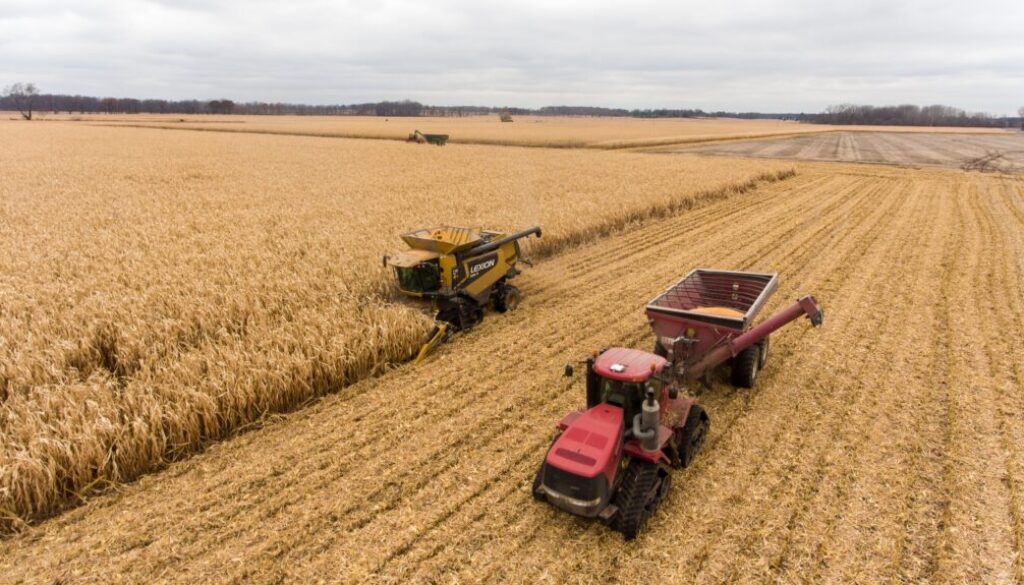As US pushes “climate-smart” agriculture, hopes and fears collide
(This is the second article in an ongoing series looking at how changing agricultural policies are affecting environmental health.)
 For decades, leading US farm leaders have likened efforts to rein in harmful climate change as attacks on agriculture itself, aligning with oil and gas industry groups to block policies aimed at reducing greenhouse gas emissions.
For decades, leading US farm leaders have likened efforts to rein in harmful climate change as attacks on agriculture itself, aligning with oil and gas industry groups to block policies aimed at reducing greenhouse gas emissions.
That stance has slowly been shifting in recent years, and now, fueled by $3.1 billion in federal grants, farm country is poised to shape a new era of “climate-smart” agricultural practices and take a significant role in addressing the dire consequences of a warming planet.
The actions can’t come fast enough. A panel of international scientists warned this month that the world faces a “rapidly closing window of opportunity to secure a liveable and sustainable future,” and that the actions implemented over the next few years will have consequences “now and for thousands of years.”
The Biden Administration’s focus on agriculture is just one part of a larger effort to address climate change, but it is a key element. By funding 141 experimental projects, the administration is hoping to push an industry currently responsible for generating 10% of U.S. greenhouse gases, to the front of the nation’s work to reduce carbon emissions.
The first grants from the US Department of Agriculture (USDA), for 70 large projects, were awarded in September. A second round of funding, for 71 smaller projects, was awarded in December.
The scope of the climate-smart program is expansive. Grants range from $271,200 to teach climate-friendly practices to immigrant farmers in Iowa to $95 million to encourage grain farmers in 12 Midwest states to use cultivation methods that build soil fertility. In between are projects to expand organic and sustainable agriculture, sequester carbon on pastures where livestock graze, and develop carbon-reducing cultivation methods on farms operated by African Americans and Native Americans.
In all, more than 60,000 farms and 25 million acres of crop and rangeland are involved, with spending reaching all 50 states and Puerto Rico, according to the USDA..
Considerable sums are also earmarked for development of scientific methods to effectively measure whether these climate-smart practices actually meet a program goal of sequestering 60 million metric tons of carbon.
When making the rounds at annual farm conferences across the country over the winter, Agriculture Secretary Tom Vilsack repeatedly declared that a “transformational” new era had opened for U.S. agriculture.
Grant recipients such as Marbleseed, a Wisconsin nonprofit that trains farmers in organic agriculture, say the government support is long overdue. Marbleseed is part of a partnership receiving a $4.5 million, five-year grant to train farmer in 14 Midwest and southern states on how to improve soil fertility.
“We’ve been a tiny voice shouting into the storm for a very long time,” said Tom Manley, Marbleseed program director. “They finally are starting to hear us.”
Questions and controversy
But amid the optimism, fears and criticism about many elements of the program persist. While the pool of grantees include 11 historically Black universities and 36 public agricultural land grant universities, many others receiving funds are large corporate agriculture players, including companies that have played a role in creating air and water pollution and other environmental woes. They include Tyson Foods, Archer Daniels Midland, John Deere, Cargill, and Exxon Mobil. The influential American Farm Bureau Federation, which recently opposed requirements for reporting greenhouse gas emissions, helped shape the program’s design and counts several state affiliates as grantees.
Given the players involved, skeptics assert that “climate-smart” could be little more than a distraction to divert attention away from agriculture’s documented record of extensive air and water pollution. Critics fear the projects may actually expand existing, ecologically insensitive methods of farming and say there has been a lack of transparency regarding details for some of the projects.
“The [USDA] hasn’t released much information, like a paragraph on each project,” added Ben Lilliston, director of rural strategies and climate change for the Institute for Agriculture and Trade Policy, a research group in Minneapolis. “There are 141 projects, all with different definitions, all defining climate-smart in their own way. It really opens it up to greenwashing.”
Silvia Secchi, professor in the department of geographical and sustainability sciences at the University of Iowa, said the USDA has declined to turn over requested documents about the projects.
“They said the reason was to protect confidential business information,” Secchi said. “They’re spending billions of public dollars. What about this program is so sensitive?”
The skeptics also point out that previous transformations in agriculture have come with painful and counter-productive consequences. Widespread adoption of pesticides, nitrogen fertilizers, and concentrated livestock feeding operations, for instance, have led to widespread pollution of waterways, decimated soil health, killed off important pollinator species and exposed people to toxins known to cause cancer and other diseases.
Evolution of “Climate-Smart”
The notion that modifying agricultural approaches could reduce carbon emissions took root over a decade ago. In 2010, the Food and Agriculture Organization of the United Nations introduced the concept of “climate-smart agriculture” and its carbon-reducing objectives in an influential report that was widely read in Washington and other world capitals.
The Obama administration got interested. Vilsack, who was serving his first stint as agriculture secretary, collaborated with John Kerry, then secretary of state and now President Biden’s special envoy for climate, to establish the Global Alliance for Climate-Smart Agriculture. It was introduced as an FAO project at the UN in 2014.
After four years of being ignored by the Trump administration, climate-smart farming became relevant again to the Biden Administration. A week after his inauguration, President Biden issued an executive order “to implement a Government-wide approach that reduces climate pollution in every sector of the economy.”
Recipients are thrilled to see funding coming their way. More than $300 million is directed to sustainable and organic farm projects, by far the most money the USDA has ever spent to bring environmentally sensitive farming into the mainstream.
But many millions more are earmarked for projects that support conventional farmers and related businesses. Among the large grants was $30 million awarded to Gevo, a Colorado renewable energy developer that is building a $875 million ethanol plant in South Dakota to produce fuel for airlines. The grant provides a 25 cents to 50 cents per bushel bonus to corn growers to supply 35 million bushels needed to produce 65 million gallons of what the USDA. calls “low-carbon intensity sustainable aviation fuel.” The key is that the farmers must grow their corn using “carbon-reducing practices.”
Those practices include time-honored approaches such as planting cover crops to build soil fertility, not plowing to keep carbon bound up in soil, and applying less fertilizer. They come with the extra benefits of control soil erosion and helping keep farm nutrients from running off into waterways.
An even larger grant of $80 million was awarded to Roeslein Alternative Energy, a Missouri company collaborating with Iowa State University, the Nature Conservancy, and 12 other groups to grow corn and soybeans, raise cattle and hogs, and produce methane from manure. The project’s innovative feature is to pay producers to plant grasses to restore prairies, and then harvest them to feed into biodigesters to produce a methane-rich biogas that can be converted to renewable natural gas. Remaining solids can be spread as fertilizer on farm fields, according to the company.
“There is so much opportunity right now in agriculture for energy,” said Roeslein spokesman Brandon Butler. “It’s figuring out how it’s sustainable. We’re at the forefront. Being able to digest biomass into clean, renewable energy coming from the Heartland.”
Potential pitfalls
Reducing greenhouse gases, say researchers, affects every facet of producing food, fiber, and now energy, and amounts to the most difficult transition ever attempted by the U.S. farm sector. According to various studies, as it has gotten more industrialized, agriculture has steadily been generating more climate-changing emissions, not less.
While the new projects aim to make agriculture more climate friendly, some of the practices being incentivized come with potential pitfalls, expert say.
For example, research published last summer by the Center for Agriculture and Food Systems at Vermont Law and Graduate School, found that manure digesters leak methane. Cows and cattle also release huge amounts of methane. Moreover, spreading the nitrogen-rich liquid wastes from digestion as fertilizer on fields increases emissions of nitrous oxide, another powerful greenhouse gas.
“Regulators and policymakers should carefully consider the climate value of replacing fossil fuels with the combustion of biomethane, especially for the magnitude of public funds invested in this displacement,” said the study’s authors. “Renewability does not necessarily mean that a fuel is sustainable or climate friendly.”
Similar critiques are made about corn grown to manufacture ethanol. The USDA asserts that ethanol produces 20% less carbon emissions than gasoline. But a peer-reviewed paper published in the Proceedings of the National Academy of Sciences of the US last year found federal policy introduced in 2007 had the effect of increasing fertilizer use, which in turn resulted in higher carbon emissions. The researchers found that overall, carbon emissions from corn production could negate any climate advantages of corn ethanol relative to gasoline.
Given the fact that Congress recently passed new legislation to increase ethanol production from 15 billion gallons in 2022 to 21 billion gallons this year, and 23 billion gallons by 2025, it is likely that the environmentally unfriendly practices associated with conventional corn production and its heavy use of nitrogen fertilizers will outweigh any “climate-smart” efforts, some fear.
Similarly, new government efforts to promote more US fertilizer production – a $500 million program announced last year – seems to run counter to efforts to slow climate change and protect the environment.
“I absolutely agree we need to be as climate-smart, as climate-friendly as possible,” said Tyler Lark, a scientist at the University of Wisconsin-Madison who was the lead author of the National Academy paper. “Agriculture is a huge contributor and has potential to be a big part of the solution. The risk is that the potential carbon savings and greenhouse gas benefits are overstated.”
(This report, co-published with Circle of Blue, was made possible by an investigative reporting fellowship awarded by the Alicia Patterson Foundation.)
(Keith Schneider, a former New York Times national correspondent, is senior editor for Circle of Blue. He has reported on the contest for energy, food, and water in the era of climate change from six continents. )
 EWG
EWG


